Renovation Wave in Europe: Low-Carbon Design for the Refurbishment of Social Housing in Southern Italy
Abstract
1. Introduction
- -
- Tackling energy poverty and worst-performing buildings;
- -
- Redevelopment of public buildings;
- -
- Decarburization of heating and cooling.
- (1)
- Energy–environmental sustainability: energy–environmental retrofitting of buildings, encouraging design strategies that promote the circular economy of the construction sector;
- (2)
- Social sustainability: renovation of the building stock through major renovations in order to improve the quality of life of occupants, with the involvement of occupants through various forms of participation;
- (3)
- Functional and aesthetic sustainability (restyling): opportunities to improve the architectural and urban quality of the territorial context to which the building complexes to be renovated belong.
2. State of the Art
2.1. Energy–Environmental Sustainability
2.2. Social Sustainability
2.3. Functional and Aesthetic Sustainability
- −
- Building replacement, a radical intervention involving the demolition of the existing built-up area and new construction; it is the extreme rationale, to be applied when there are no physical and social prerequisites and requirements such that an artifact can be reused over time.
- −
- Construction on the built, an operation that involves layering and overlaying on the existing built. Some of Herzog&de Meuron’s projects, including the aforementioned Hamburg Philharmonic, are indicative. In general, an awareness of the work is maturing that brings the theme of building on the built back to the center of architectural and urban design practice, which is accompanied by extended critical attention to the notion of heritage and the common good ([37], p. 88).
- −
- Transformation, more or less profound. This is an operation that produces results of different intensities in which volumetric addition and subtraction play a key role, practiced according to different criteria, intensities, and dimensions (Figure 1 and Figure 2). The current condition of the urban building stock, especially in Europe, at a time of impending economic crisis has made transformation one of the few feasible programs through which we attempt to combat the waste that played a decisive role in triggering the crisis, the waste of energy, time, and resources of all kinds due to the unnecessary movement of men and goods […]. Architecture is continually transformed by those who design and build it, but it is also true that, considering it as an expression of the society and culture of a given time, it resembles something like a living organism that undergoes continual metamorphoses [38]. There are interventions that contemplate refunctionalization, understood as an intervention aimed at giving a new destination compatible with the context. In Vienna, the “Gasometers”, decommissioned in 1984, were declared a national monument. They were used in various ways and by various entities for ten years until, in 1995, the government decided to hold an international design competition to restore the four monuments. Jean Nouvel (creator of the creation of a covered plaza with a translucent roof that, through a play of refractions, synthesizes the old–new pair), Coop Himmelbau (creator of the addition of three volumes to the existing façade), and Manfred Wedhorn, who adopted the “greener” approach, adding terraces and interior gardens, were, respectively, chosen for Gasometers A, B, and C. In contrast, the design of Gasometer D was entrusted to Wilhelm Holzbauer [39]. The other cases represent interventions in the transformation of buildings and contexts that originally arose with residential use, which, over the course of redevelopment, maintained the same purpose.
3. Tools and Methods
- −
- Module ‘A’ is inherent in the choice of materials; the database used for this phase (from cradle to gate) is the University of Bath’s Inventory Carbon&Energy (ICE) [42]. In the case of composite products, reference was made to the Environmental Product Declaration (EPD) inventory.
- −
- Module ‘C’ includes the deconstruction of the building and the transportation of materials to disposal or recovery/recycling sites. Emissions reported in the data sheets of demolition equipment and their time of use were used to calculate the EC.
- −
- Module ‘D’ includes the impacts/benefits associated with demolition, transportation, and waste disposal/treatment. Potential positive impacts however can be obtained from reuse and recycling after end of life.
3.1. Concept Design
- −
- Replacement involves the replacement of functional elements or parts with others of superior performance or new performance not guaranteed by the original elements;
- −
- Integration concerns the addition of building elements to existing parts such as subsystems or building components, which are parts that are not removed but remain in situ and are, possibly, subject to maintenance and restoration, with the purpose of increasing existing performance or adding new performance;
- −
- Addition concerns the action aimed at adding technical elements, parts of buildings or entire volumes to the building, as an extension of the original building (Figure 5);
- −
- Final subtraction concerns the action aimed at eliminating technical elements, factory parts, or entire volumes in order to achieve new or higher performance due to the new configuration of the building.
3.2. Construction Scenarios
3.3. Demolition Scenarios
3.3.1. Scenario D1—Reuse
3.3.2. Scenario D2—Recycling
3.3.3. Scenario D3—Disposal
3.4. Methodological Approach
4. Case Study: Refurbishment and Restyling of a Social Housing Complex in Southern Italy
4.1. Description of the Case Study
4.2. Design Hypotheses
4.3. Design Solution No. 1: Construction
- −
- The addition structure on the south front is steel, consisting of HEB180 columns, edge beams with IPE330 profiles, interior beams with IPE220 profiles, and IPE120 secondary beams. IPE 330 profiles were retained for the central part.
- −
- The external envelope, which forms the façade on the additional body, consists of photovoltaic panels on the elevation, alternating with appropriate openings. A 15 cm-thick rock wool insulation layer is provided, incorporated within HEB180 load-bearing metal profile, a 10 cm air gap with modular breaks of 100 × 50 mm steel box profiles such that a 12.5 cm thick fiber cement slab can be attached, followed by an exterior finishing layer. To the latter are doweled 50 × 50 mm supports for fixing the photovoltaic panels on the façade.
- −
- The intermediate slab has a steel structure, as well as IPE 330 and IPE 220 profiles; secondary IPE220 profiles are structured, proceeding towards each other in the slab stratigraphy by 1.5 mm thick corrugated metal sheet, structural screed with 12.5 cm electro-welded mesh, a 10 cm rock wool insulation layer, a 5 cm bedding screed, and 1.5 cm terracotta flooring. At the soffit, a lightweight metal structure is used for a gypsum-fiber paneled ceiling.
- −
- The roofing has dry stratigraphy, a steel structure, IPE330 and IPE220 profiles, and IPE220 secondary profiles, on which 1.5 mm corrugated metal sheet rests, followed by screed with 12.5 cm electro-welded mesh, a 0.5 mm PVC waterproofing sheet, a 16 cm rock wool layer, an EPS layer, and finally a 3 mm waterproofing sheathing. As a finish on the soffit, there is a light metal structure for a false ceiling in gypsum-fiber paneling (Figure 13).
4.4. Design Solution No. 2: Demolition + Construction
5. Application to Case Study
5.1. Design Solution No. 1
5.1.1. Scenario C1—Starting Situation (Baseline)
5.1.2. Scenario C2—Adoption of Secondary Raw Materials
5.1.3. Scenario C3—Alternative Technological Solutions
- −
- Replacement of insulation material with one with low- CO2e emissions; rock wool is replaced with wood fiber panel.
- −
- Replacement of interfloor construction technology; the present stratigraphy (floor with a “wet” system) is replaced with “dry” technology (Figure 17).
5.2. Design Solution No. 2
5.2.1. Demolition
5.2.2. Scenario D1—Reuse
5.2.3. Scenario D2—Recycling
5.2.4. Scenario D3—Disposal
6. Results and Discussion
6.1. Results of Design Solution No. 1
6.2. Results of Design Solution No. 2
7. Conclusions
- −
- Reducing energy poverty and the number of low-performing buildings; fostering renovations for low-income groups through minimum energy performance standards coupled with financing that limits residents’ spending.
- −
- Renovating public buildings (e.g., administrative, educational, and healthcare facilities); orienting public agencies toward the principle of energy efficiency and increasing the annual renovation obligation so as to foster a pathfinder role for public infrastructure in terms of building renovation, thus serving as a model.
- −
- Modernizing building heating and cooling systems to decarbonize the EU building stock, harness local renewable energy potential, and reduce the EU’s dependence on fossil fuel imports.
Funding
Data Availability Statement
Conflicts of Interest
References
- Directive (EU) 2023/1791 of the European Parliament and of the Council of 13 September 2023 on Energy Efficiency and Amending Regulation (EU) 2023/955. Available online: https://eur-lex.europa.eu/legal-content/EN/TXT/?uri=OJ%3AJOL_2023_231_R_0001&qid=1695186598766 (accessed on 20 May 2024).
- Paris Agreement. Paris, 12 December 2015. Available online: https://treaties.un.org/pages/ViewDetails.aspx?src=TREATY&mtdsg_no=XXVII-7-d&chapter=27&clang=_en (accessed on 20 May 2024).
- IEA. Perspectives for the Clean Energy Transition: The Critical Role of Buildings. International Energy Agency. 2019. Available online: https://www.iea.org/reports/the-critical-role-of-buildings (accessed on 20 May 2024).
- Pomianowski, M.Z.; Johra, H.; Marszal-Pomianowska, A.; Zhang, C. Sustainable and energy-efficient domestic hot water systems: A review. Renew. Sustain. Energy Rev. 2020, 128, 109900. [Google Scholar] [CrossRef]
- Zhang, S.; Ocłoń, P.; Klemeš, J.J.; Michorczyk, P.; Pielichowska, K.; Pielichowski, K. Renewable energy systems for building heating, cooling and electricity production with thermal energy storage. Renew. Sustain. Energy Rev. 2022, 165, 112560. [Google Scholar] [CrossRef]
- Greenwood, D.; Walker, S.; Wade, N.; Munoz-Vaca, S.; Crossland, A.; Patsios, C. 30-Integration of High Penetrations of Intermittent Renewable Generation in Future Electricity Networks Using Storage. In Future Energy, 3rd ed.; Improved, Sustainable and Clean Options for our Planet; Elsevier: Amsterdam, The Netherlands, 2020; pp. 649–668. [Google Scholar] [CrossRef]
- Dechezleprêtre, A.; Nachtigall, D.; Venmans, F. The joint impact of the European Union emissions trading system on carbon emissions and economic performance. J. Environ. Econ. Manag. 2023, 118, 102758. [Google Scholar] [CrossRef]
- Rabani, M.; Madessa, H.B.; Nord, N. A state-of-art review of retrofit interventions in buildings towards nearly zero energy level. Energy Procedia 2017, 134, 317–326. [Google Scholar] [CrossRef]
- Flores, I. A value-based framework from Building Stock Model to Retrofit Model. Int. J. Environ. Sci. Sustain. Dev. 2024, 9, 20–31. [Google Scholar] [CrossRef]
- Balaras, C.; Dascalaki, E. Decarbonizing the European Building Stock-Past-Present-Future. In Proceedings of the International Building Decarbonization 2022 Conference, Athens, Greece, 5–7 October 2022. [Google Scholar] [CrossRef]
- Wade, F.; Visscher, H. Retrofitting at scale: Accelerating capabilities for domestic building stocks. Build. Cities 2021, 2, 800–911. Available online: https://www.research.ed.ac.uk/en/publications/retrofit-at-scale-accelerating-capabilities-for-domestic-building (accessed on 20 May 2024). [CrossRef]
- Jensen, P.A.; Maslesa, E.; Berg, J.B.; Thuesen, C. 10 questions concerning sustainable building renovation. J. Affect. Disord. 2017, 143, 130–137. [Google Scholar] [CrossRef]
- Jensen, P.A.; Maslesa, E.; Berg, J.B. Sustainable Building Renovation: Proposals for a Research Agenda. Sustainability 2018, 10, 4677. [Google Scholar] [CrossRef]
- Ástmarsson, B.; Jensen, P.A.; Maslesa, E. Sustainable renovation of residential buildings and the landlord/tenant dilemma. Energy Policy 2013, 63, 355–362. [Google Scholar] [CrossRef]
- Shnapp, S.; Sitjà, R.; Jens Laustsen, J. Global Buildings Performance Network 2013. What Is a Deep Renovation Definition? Technical Report. Global Buildings Performance Network. 2013. Available online: https://www.gbpn.org/wp-content/uploads/2021/06/08.DR_TechRep.low_.pdf (accessed on 20 May 2024).
- Femenías, P.; Mjörnell, K.; Thuvander, L. Rethinking deep renovation: The perspective of rental housing in Sweden. J. Clean. Prod. 2018, 195, 1457–1467. [Google Scholar] [CrossRef]
- Fawcett, T. Exploring the time dimension of low carbon retrofit: Owner-occupied housing. Build. Res. Inf. 2014, 42, 477–488. [Google Scholar] [CrossRef]
- Gluch, P.; Gustafsson, M.; Baumann, H.; Lindahl, G. From tool-making to tool-using–and back: Rationales for adoption and use of LCC. Int. J. Strat. Prop. Manag. 2018, 22, 179–190. [Google Scholar] [CrossRef]
- Mjörnell, K.; Boss, A.; Lindahl, M.; Molnar, S. A Tool to Evaluate Different Renovation Alternatives with Regard to Sustainability. Sustainability 2014, 6, 4227–4245. [Google Scholar] [CrossRef]
- Malmgren, L.; Mjörnell, K. Application of a Decision Support Tool in Three Renovation Projects. Sustainability 2015, 7, 12521–12538. [Google Scholar] [CrossRef]
- Malmgren, L.; Elfborg, S.; Mjörnell, K. Development of a decision support tool for sustainable renovation—A case study. Struct. Surv. 2016, 34, 3–11. [Google Scholar] [CrossRef]
- Gade, A.N.; Larsen, T.S.; Nissen, S.B.; Jensen, R.L. REDIS: A value-based decision support tool for renovation of building portfolios. J. Affect. Disord. 2018, 142, 107–118. [Google Scholar] [CrossRef]
- Osterbring, M.; Camarasa, C.; Nageli, C.; Thuvander, L.; Wallbaum, H. Prioritizing deep renovation for housing portfolios. Energy Build. 2019, 202, 109361. [Google Scholar] [CrossRef]
- Nägeli, C.; Farahani, A.; Österbring, M.; Dalenbäck, J.-O.; Wallbaum, H. A service-life cycle approach to maintenance and energy retrofit planning for building portfolios. J. Affect. Disord. 2019, 160, 106212. [Google Scholar] [CrossRef]
- Thuvander, L.; Femenías, P.; Mjörnell, K.; Meiling, P. Unveiling the Process of Sustainable Renovation. Sustainability 2012, 4, 1188–1213. [Google Scholar] [CrossRef]
- Serrano-Jiménez, A.; Femenías, P.; Thuvander, L.; Barrios-Padura, A. A multi-criteria decision support method towards selecting feasible and sustainable housing renovation strategies. J. Clean. Prod. 2021, 278, 123588. [Google Scholar] [CrossRef]
- Mangold, M.; Österbring, M.; Wallbaum, H.; Thuvander, L.; Femenias, P. Socio-economic impact of renovation and energy retrofitting of the Gothenburg building stock. Energy Build. 2016, 123, 41–49. [Google Scholar] [CrossRef]
- Buser, M.; Carlsson, V. What you see is not what you get: Single-family house renovation and energy retrofit seen through the lens of sociomateriality. Constr. Manag. Econ. 2017, 35, 276–287. [Google Scholar] [CrossRef]
- Tjørring, L.; Gausset, Q. Drivers for retrofit: A sociocultural approach to houses and inhabitants. Build. Res. Inf. 2019, 47, 394–403. [Google Scholar] [CrossRef]
- Alessi, A. Riguadagnare lo spazio. In Materialegno 4; Lo Spazio Ritrovato: Milano, Italy, 2011. [Google Scholar]
- Daglio, L. Nuovo Suolo: Riuso e Recupero Delle Superfici in Quota Degli Edifici in, “Costruire Nel Costruito. Architettura a Volume Zero”, Collana Architettura e Città. Argomenti di Architettura, Milano 2012. 2012. Available online: https://re.public.polimi.it/handle/11311/692634#.WE7i-rLhCR0 (accessed on 20 May 2024).
- Reale, L. Densità, città, residenza. In Tecniche di Densificazione e Strategie Anti-Sprawl; Gangemi Editore: Roma, Italy, 2008. [Google Scholar]
- Ferrante, A.; Cattani, E.; Bartolini, N.; Semprini, G. La riqualificazione energetica e architettonica del patrimonio edilizio recente. Il caso dei quartieri di edilizia residenziale pubblica. IN_BO. Ricerche E Progetti Per Il Territorio, La Città E l’architettura 2012, 3, 251–276. [Google Scholar] [CrossRef]
- Spagnolo, R. La rigenerazione urbana come problema di ri-composizione architettonica. In Marta Calzolaretti, Domizia Mandolesi (a cura di); Rigenerare Tor Bella Monaca: Macerata, Italy, 2014; p. 83. [Google Scholar]
- Calzolaretti, M. Perché Tor Bella Monaca. Il programma di ricerca. In Marta Calzolaretti, Domizia Mandolesi (a cura di); Rigenerare Tor Bella Monaca: Macerata, Italy, 2014; p. 17. [Google Scholar]
- Sicignano, E. La demolizione quale esorcismo del male sociale: Il caso delle Vele di Scampia a Napoli. In Rita Maria Borboni; Città&Criminalità: Pesaro, Italy, 2005; pp. 233–241. [Google Scholar]
- Valente, I. Consolidare e ri-misurare i margini urbani: Una ricerca progettuale per Tor Bella Monaca. In Marta Calzolaretti, Domizia Mandolesi (a cura di); Rigenerare Tor Bella Monaca: Macerata, Italy, 2014. [Google Scholar]
- Portoghesi, P. Materia n.44-45; Quarzo Editor, Reggio Emilia: Milano, Italy, 2012; pp. 35–39. [Google Scholar]
- Wien, Gasometer D, Wilhelm Holzbauer, Blick aus einer Dachwohnung. 2001. Available online: https://www.alamy.com/wien-gasometer-d-wilhelm-holzbauer-2001-blick-aus-einer-dachwohnung-image221171876.html (accessed on 20 May 2024).
- EN ISO 14025:2010; Environmental Labels and Declarations—Type III Environmental Declarations—Principles and Procedures (ISO 14025:2006). SIST: Ljubljana, Slovenia, 2010.
- BS EN 15978:2011; Sustainability of Construction Works—Assessment of Environmental Performance of Buildings—Calculation Method. BSI: London, UK, 2011.
- Embodied Carbon-The ICE Database. Available online: https://circularecology.com/embodied-carbon-footprint-database.html (accessed on 20 May 2024).
- Califano, L. Additions to the Built in Retrofit Strategies. Doctoral Thesis, University of Naples “Federico II”, Napoli, Italy. Available online: http://www.fedoa.unina.it/8970/1/Califano_Luisa_24.pdf (accessed on 27 March 2024).
- Parlato, S. Re-Inhabiting the City, the Strategy of Addition as an Opportunity for Densification. Ph.D. Thesis, University of RomaTre, Department of Architecture, Rome, Italy, 2014. [Google Scholar]

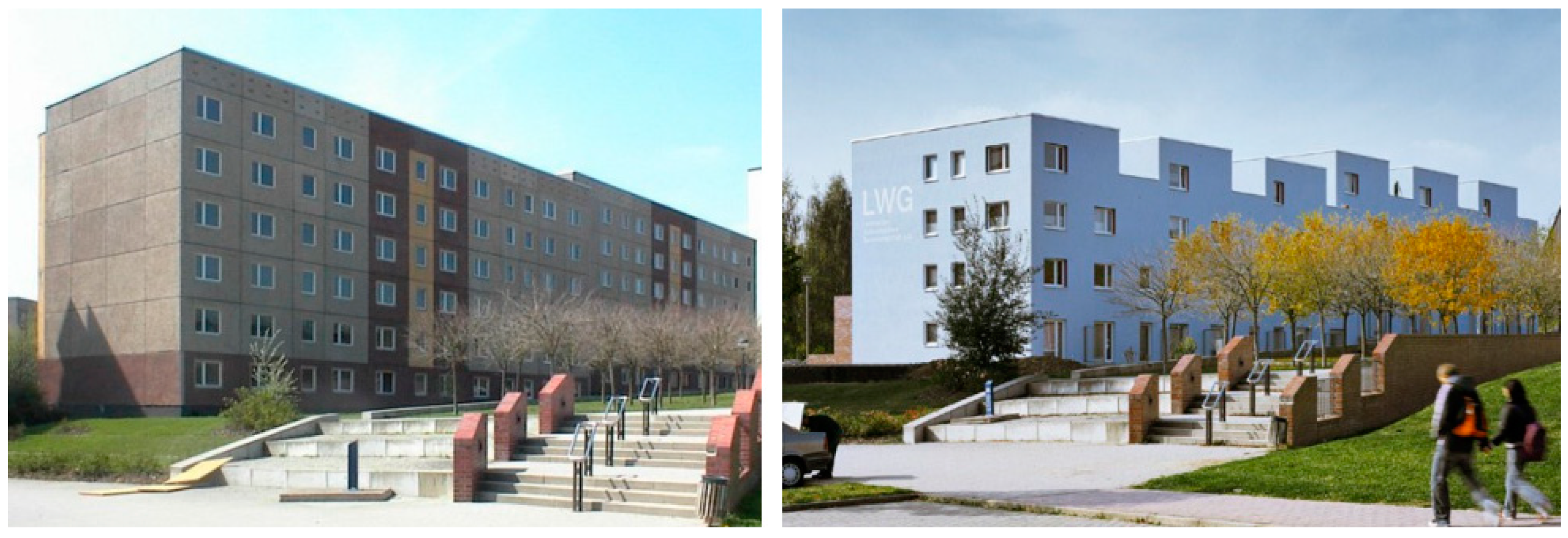

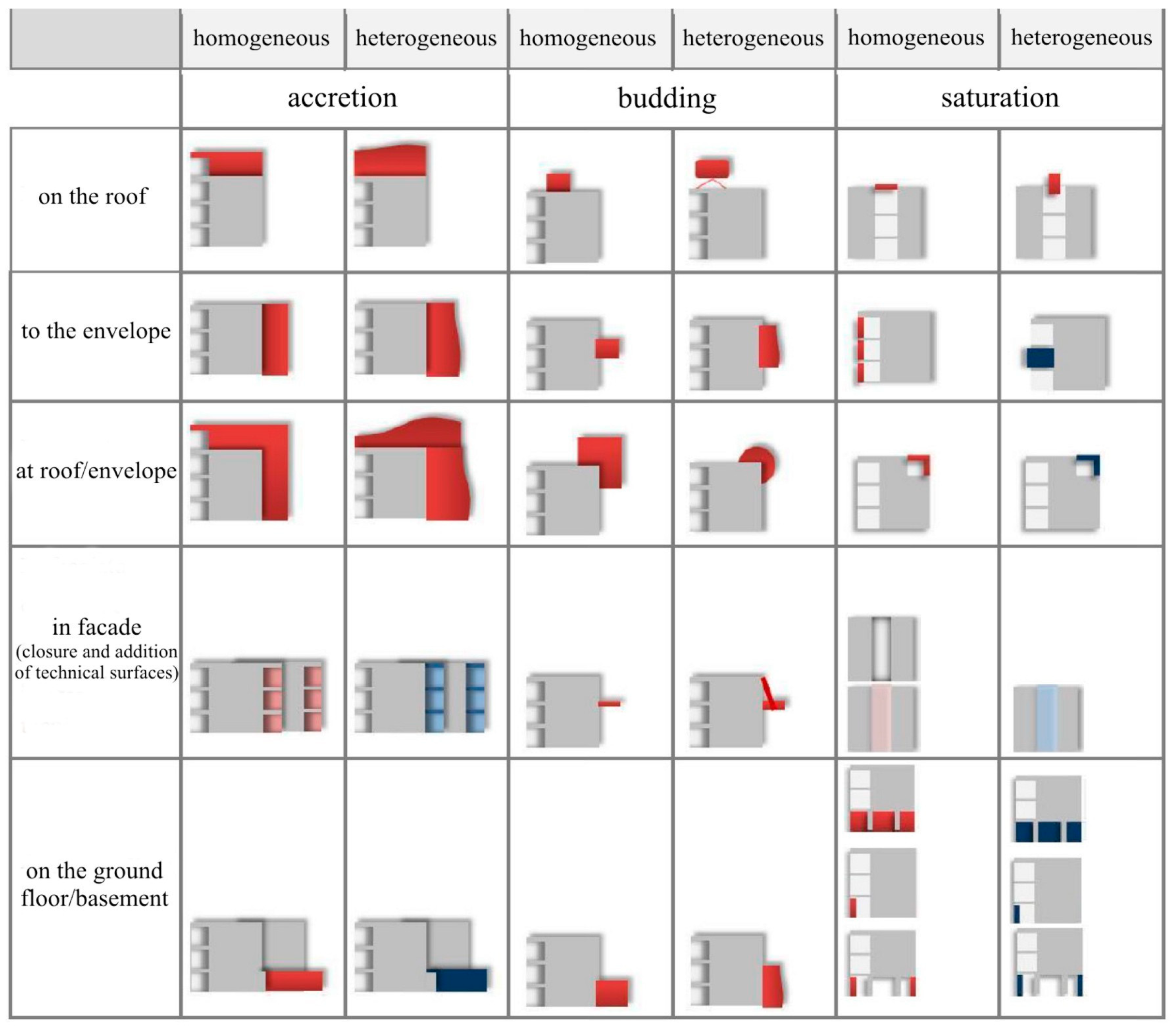

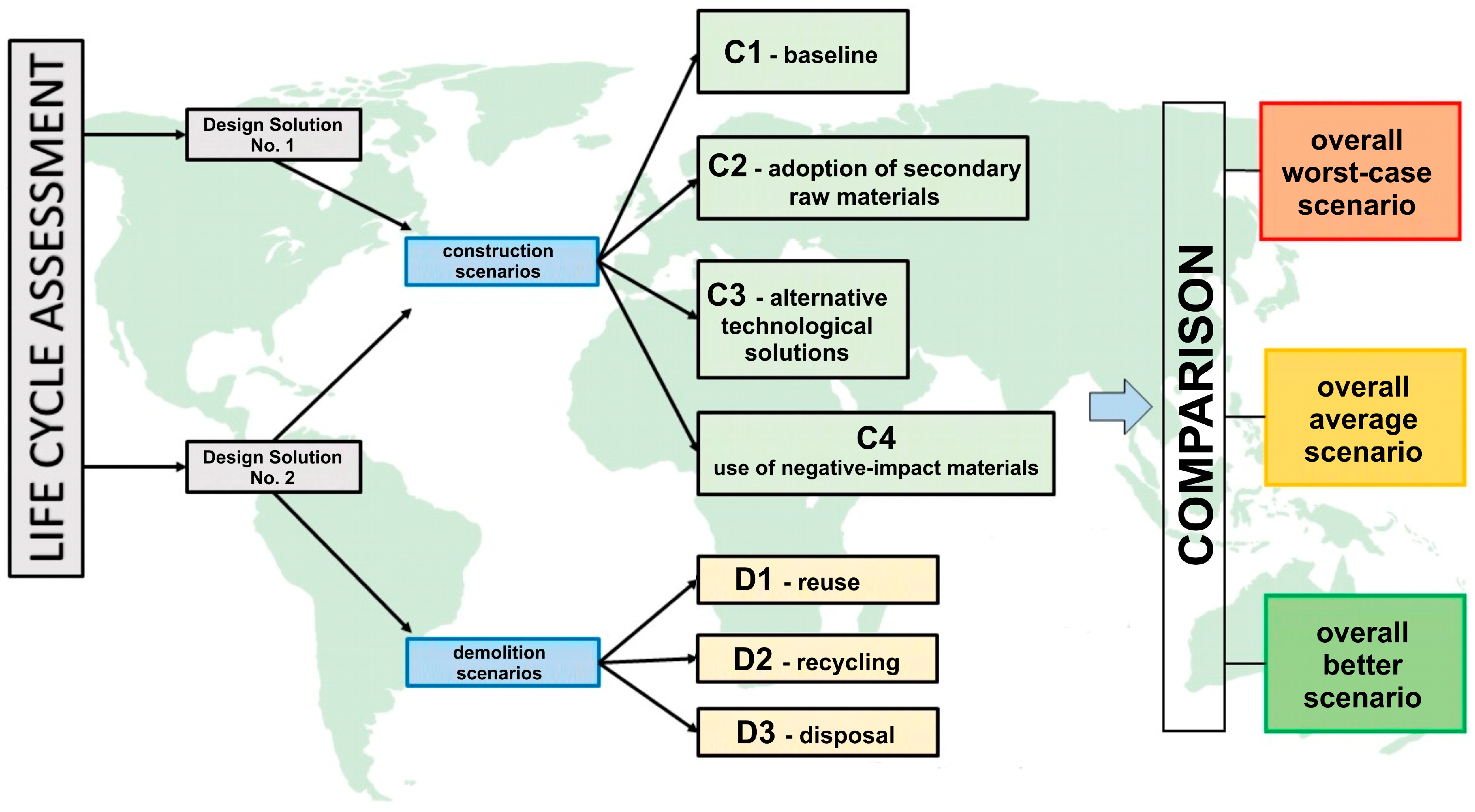

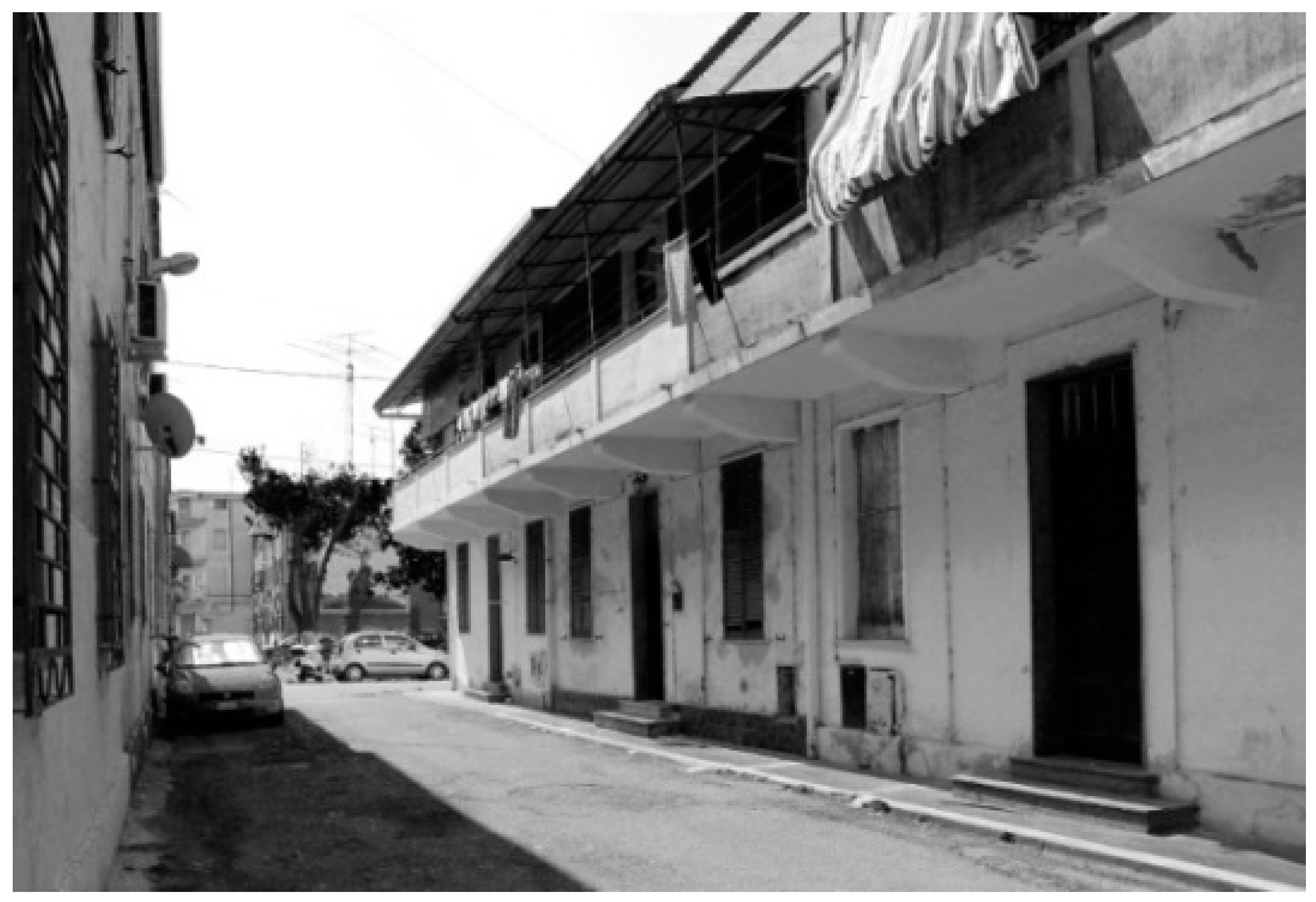
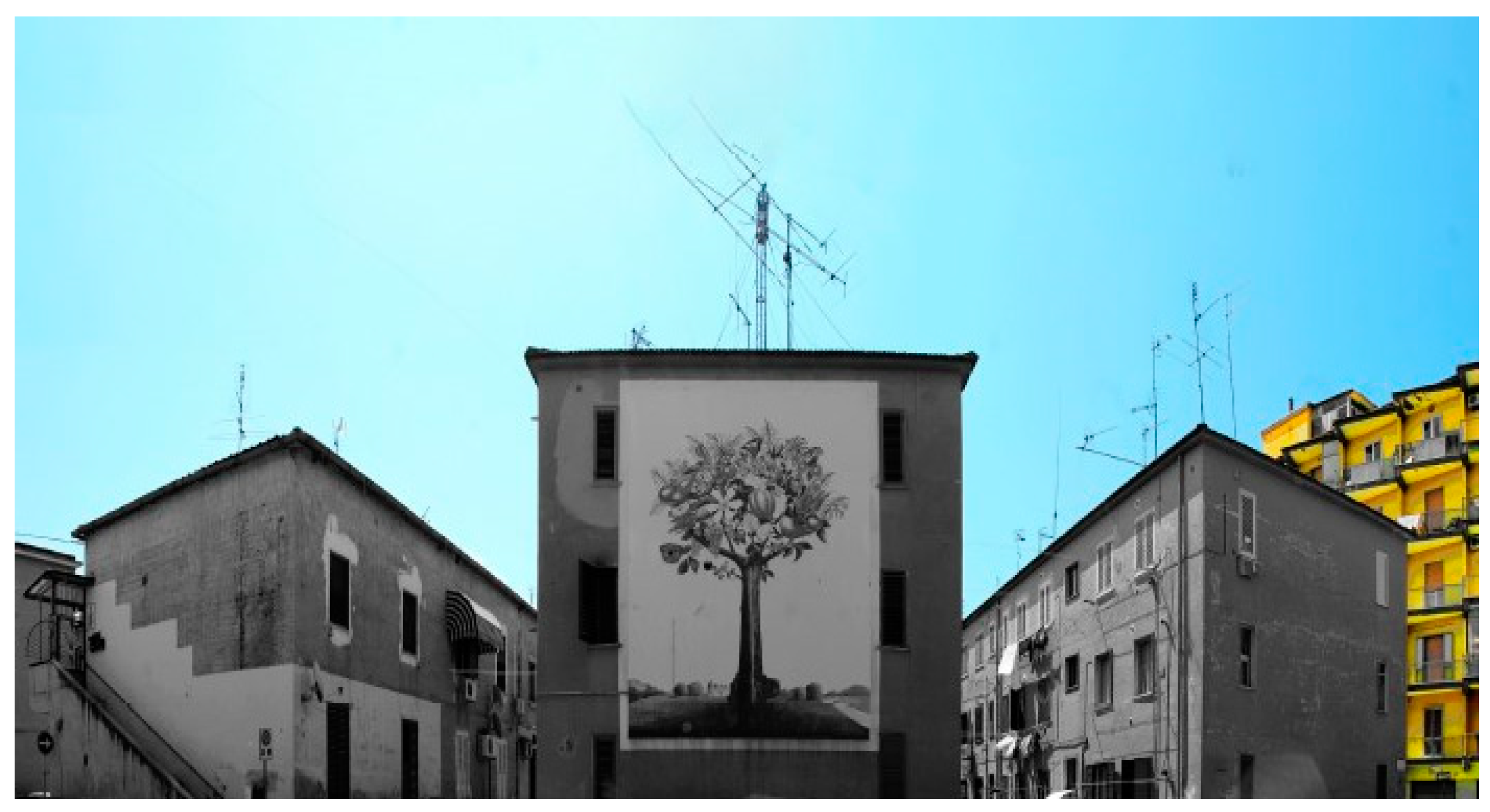
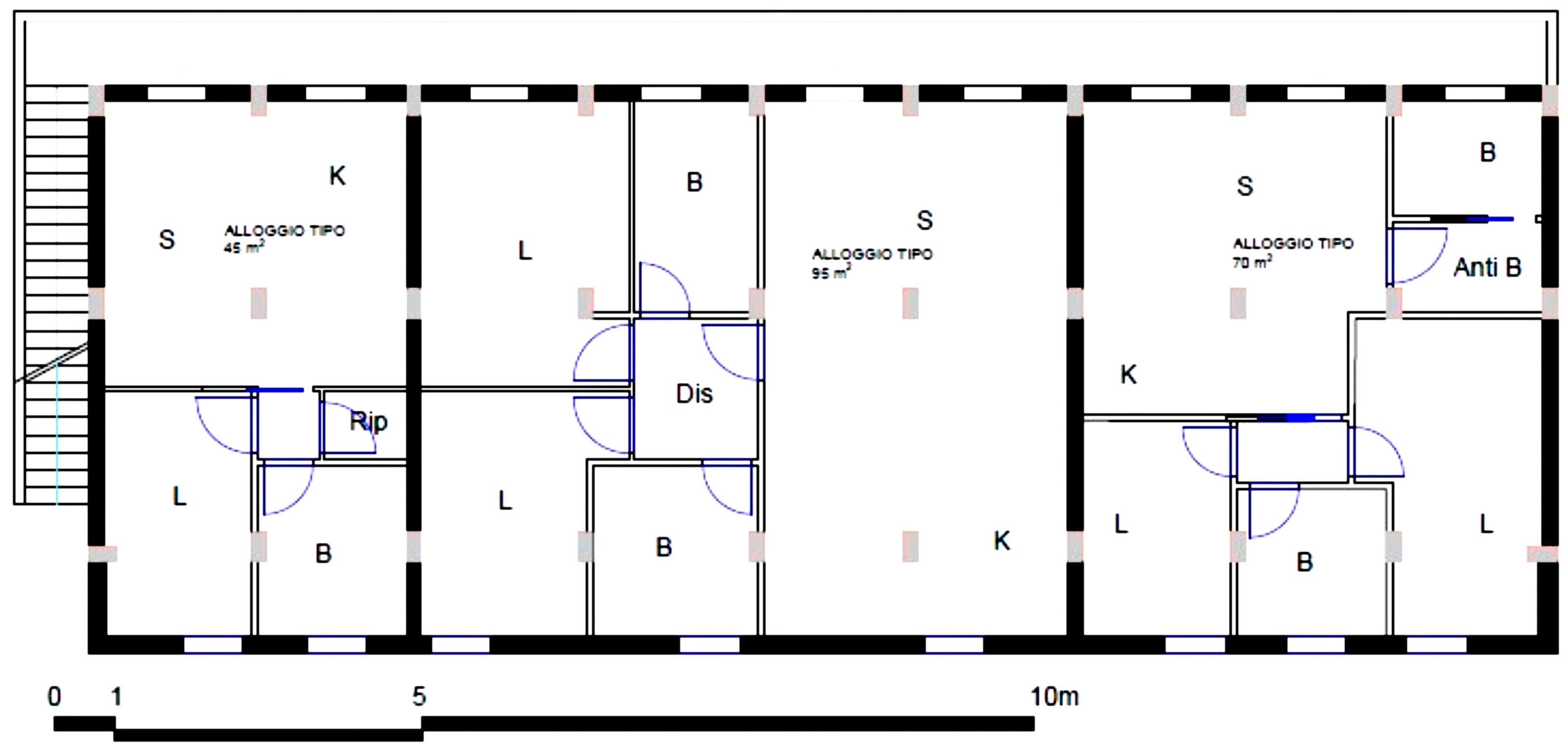
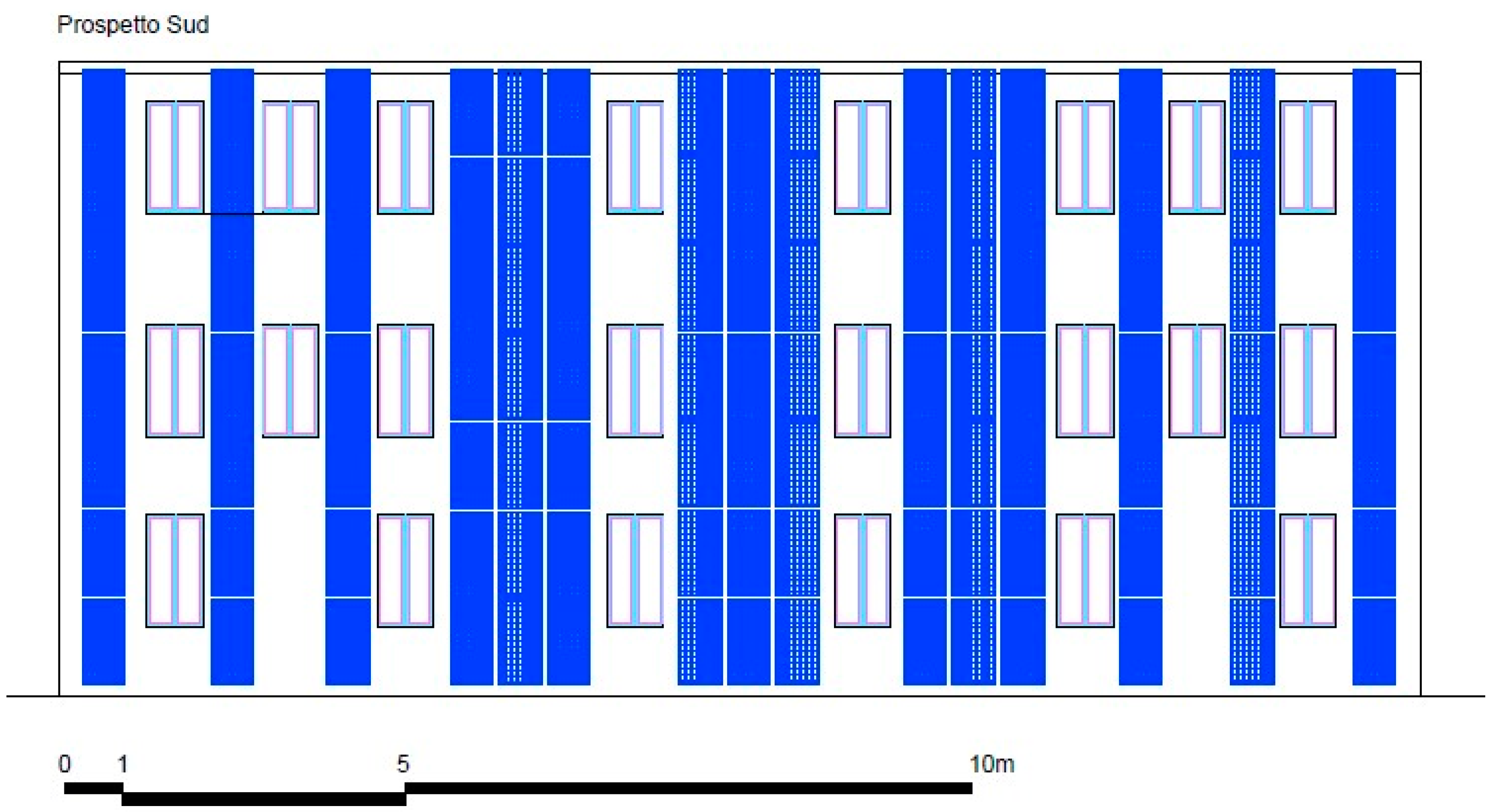
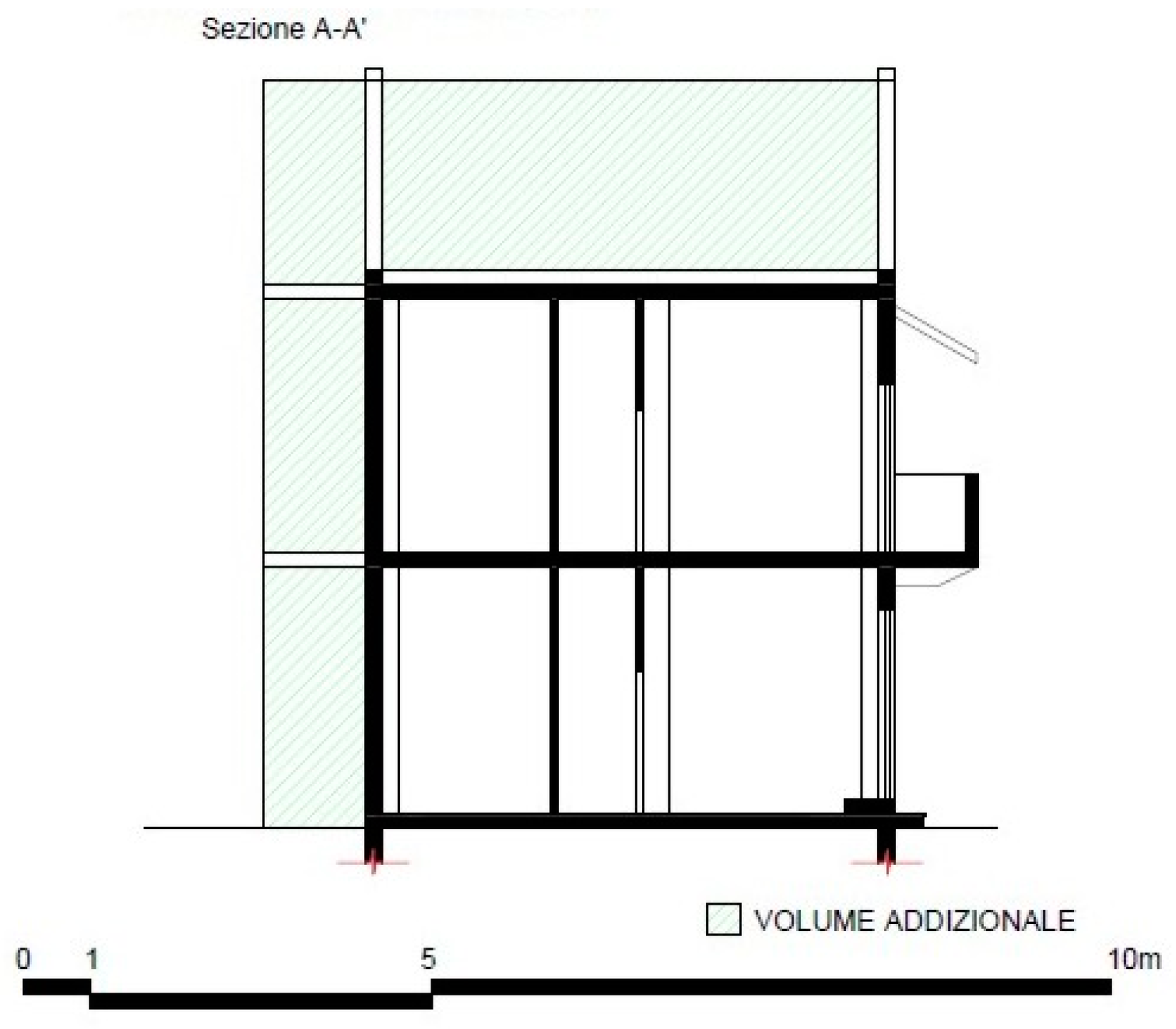
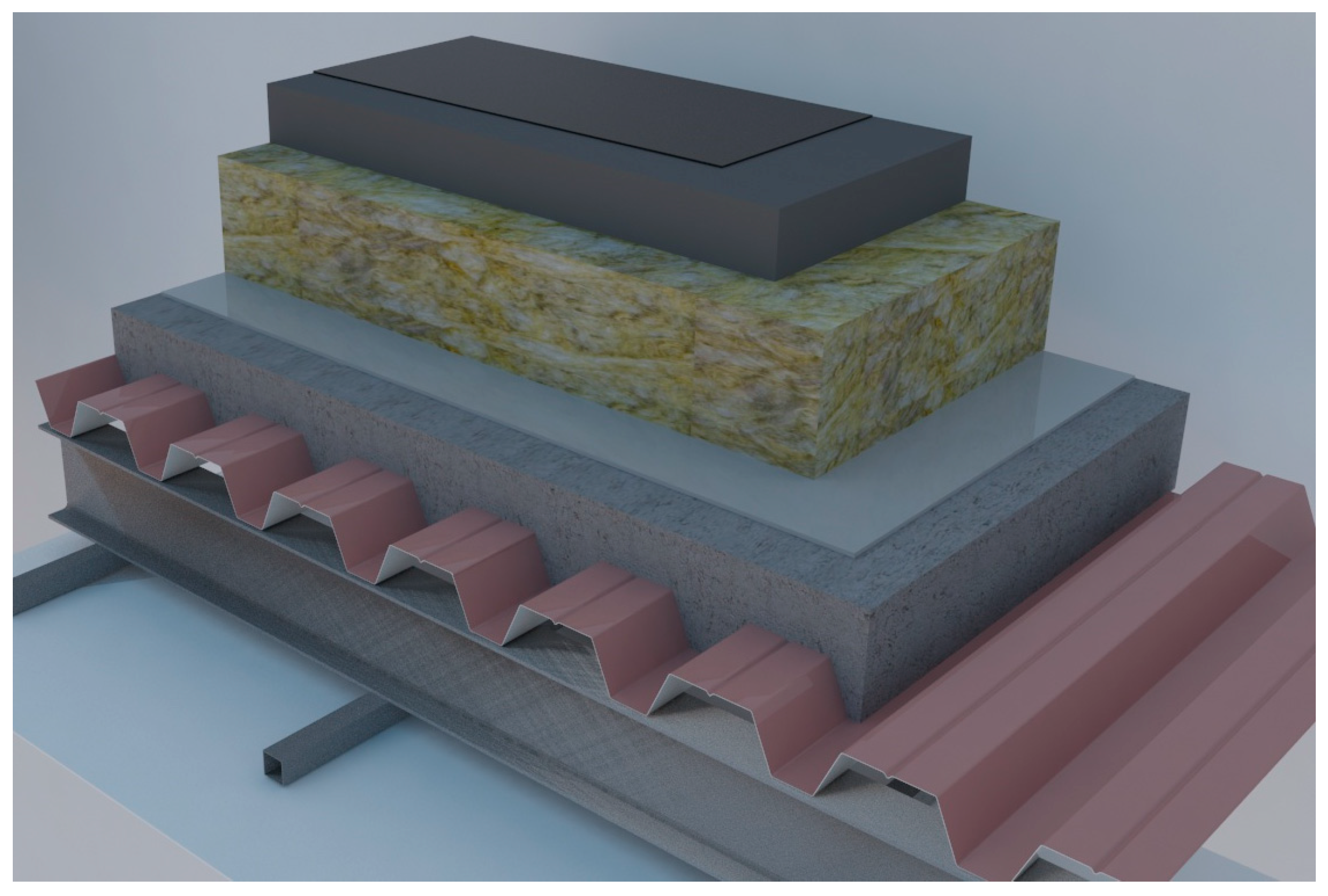

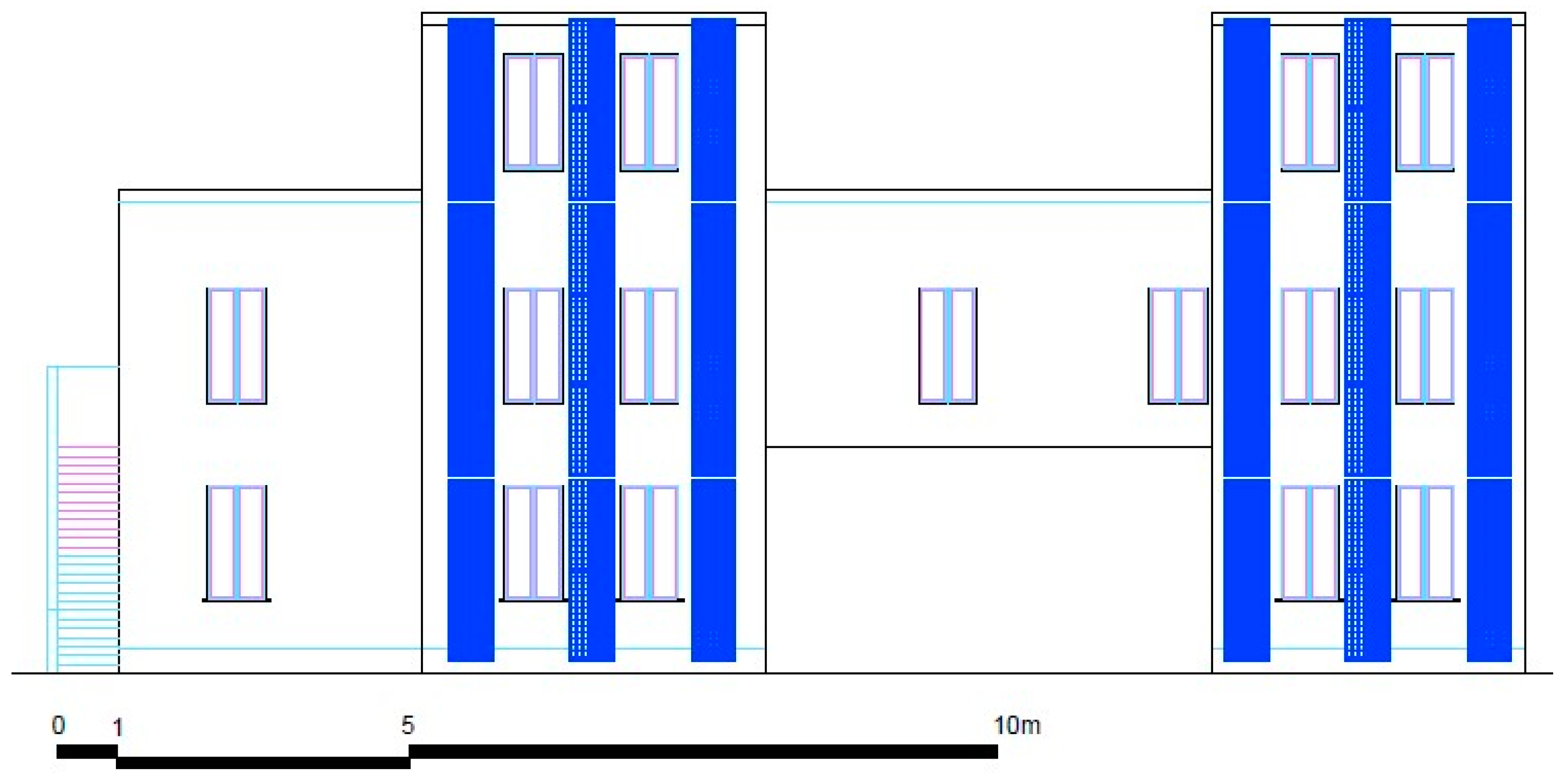
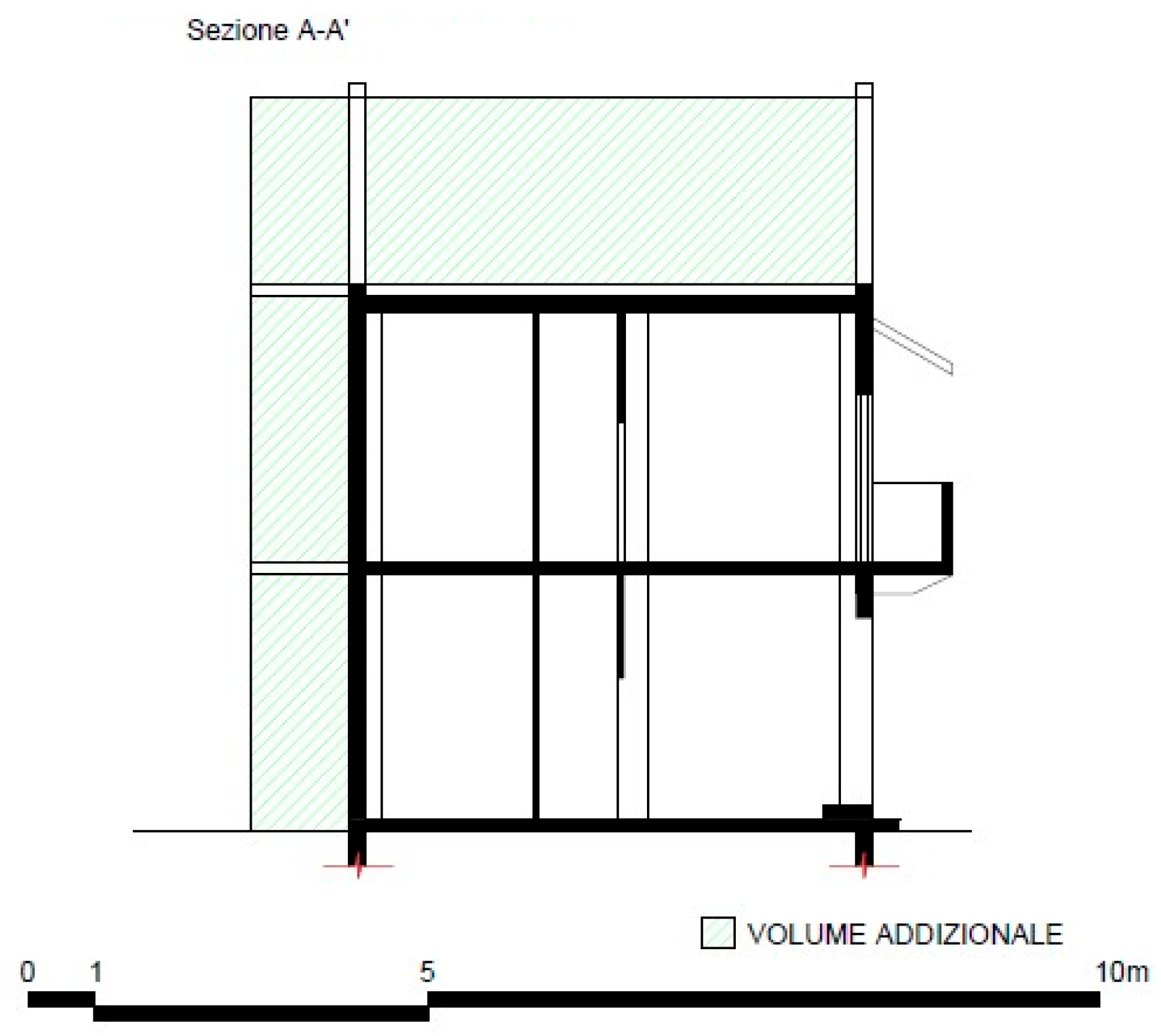
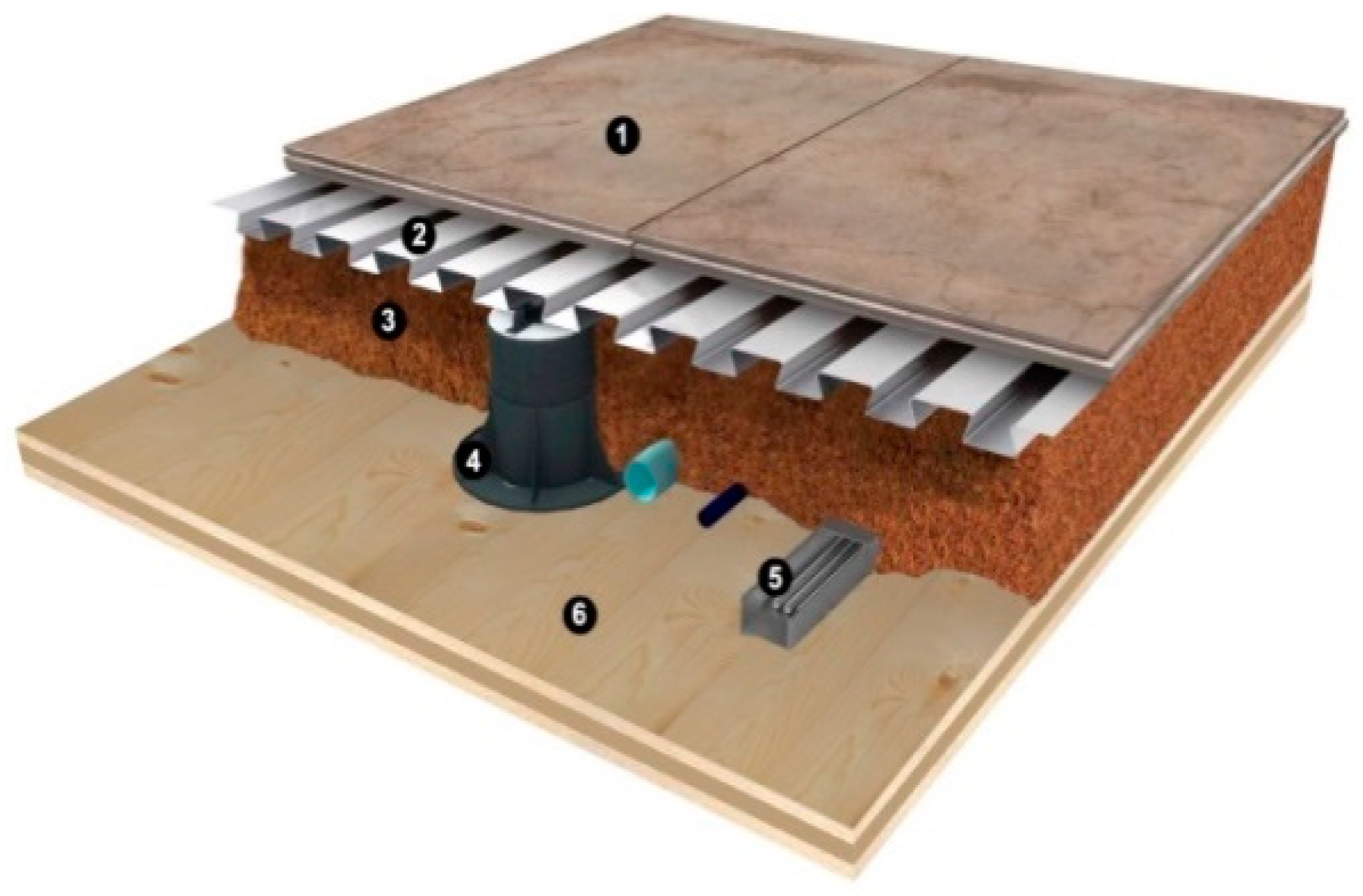
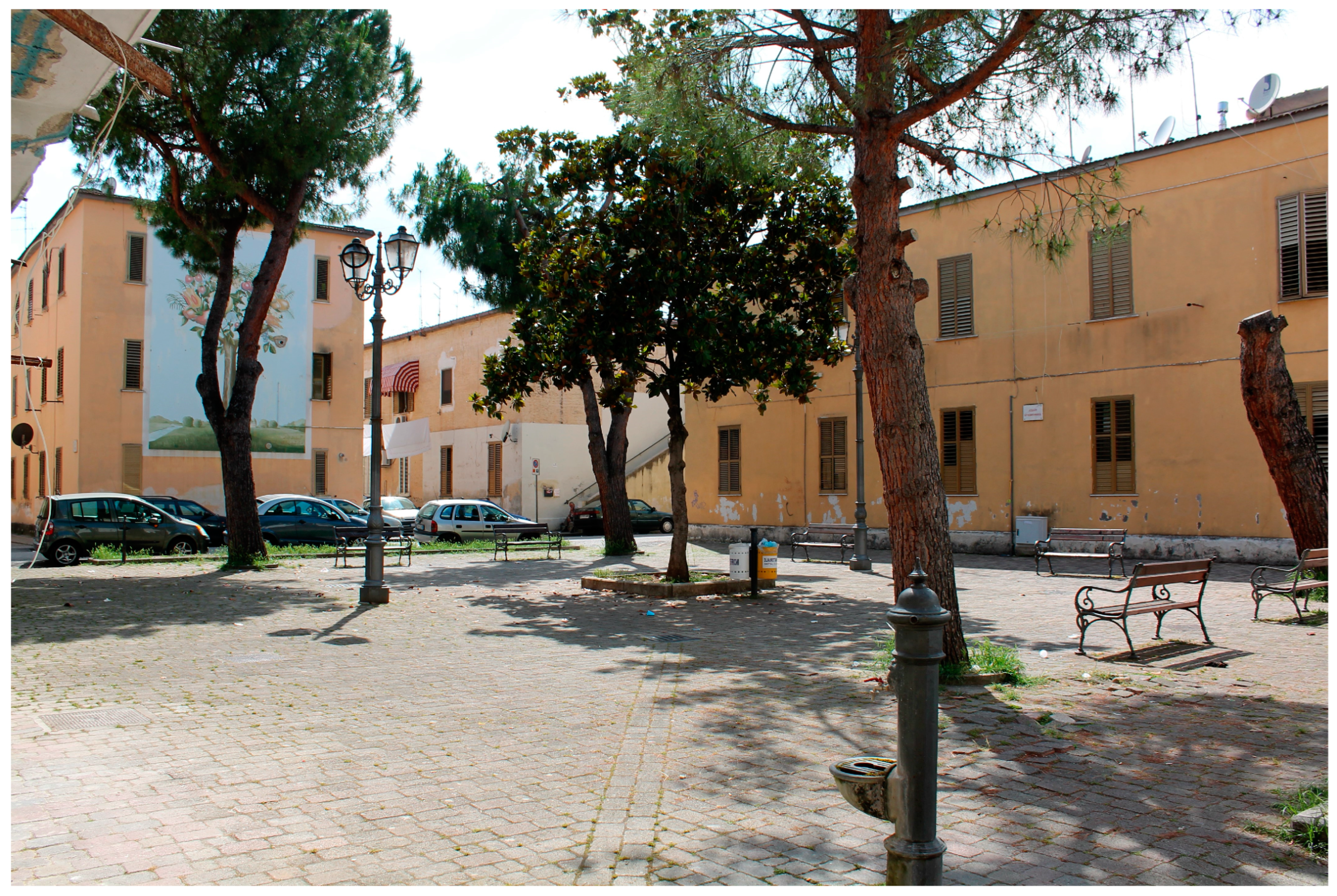
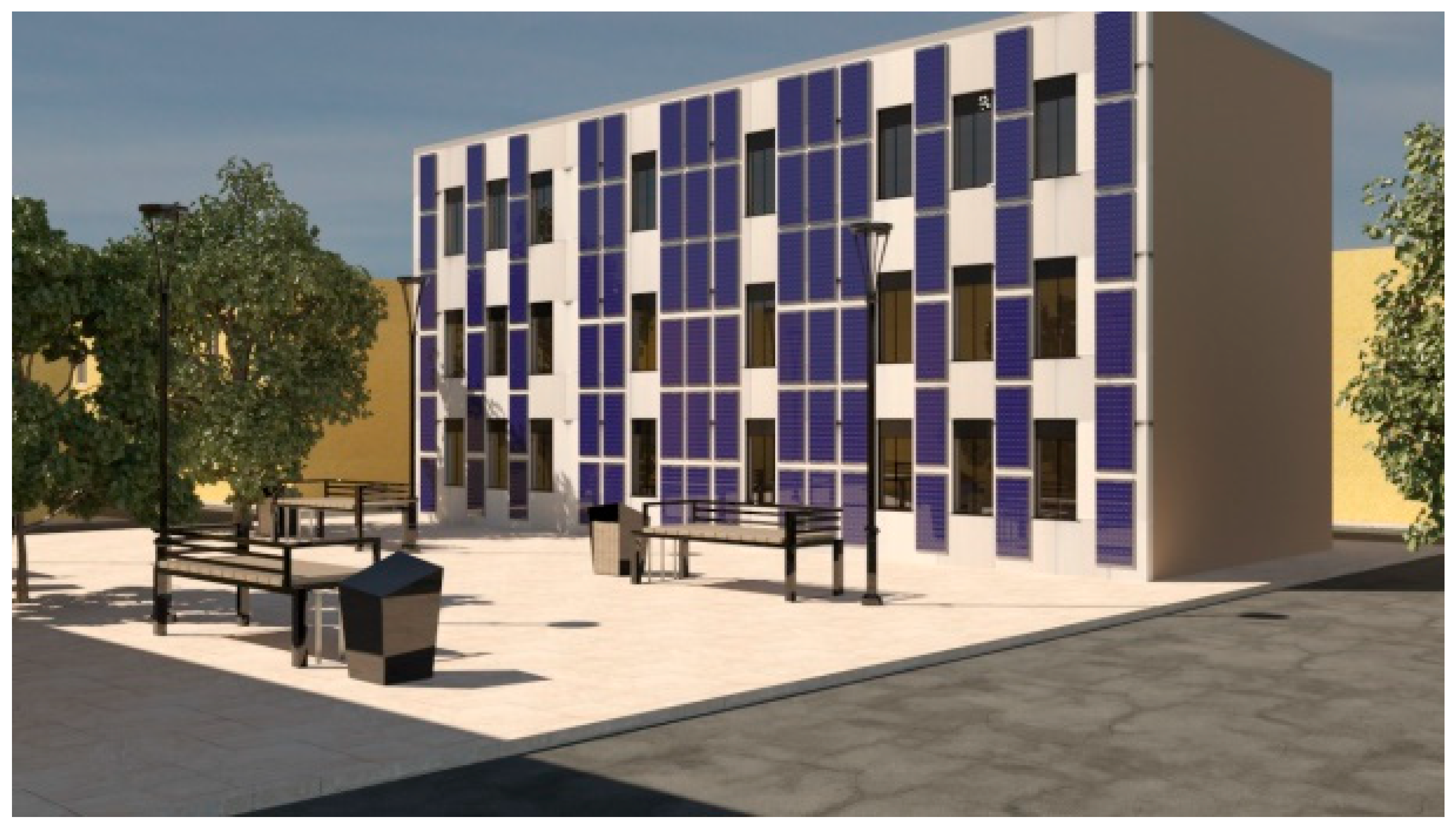
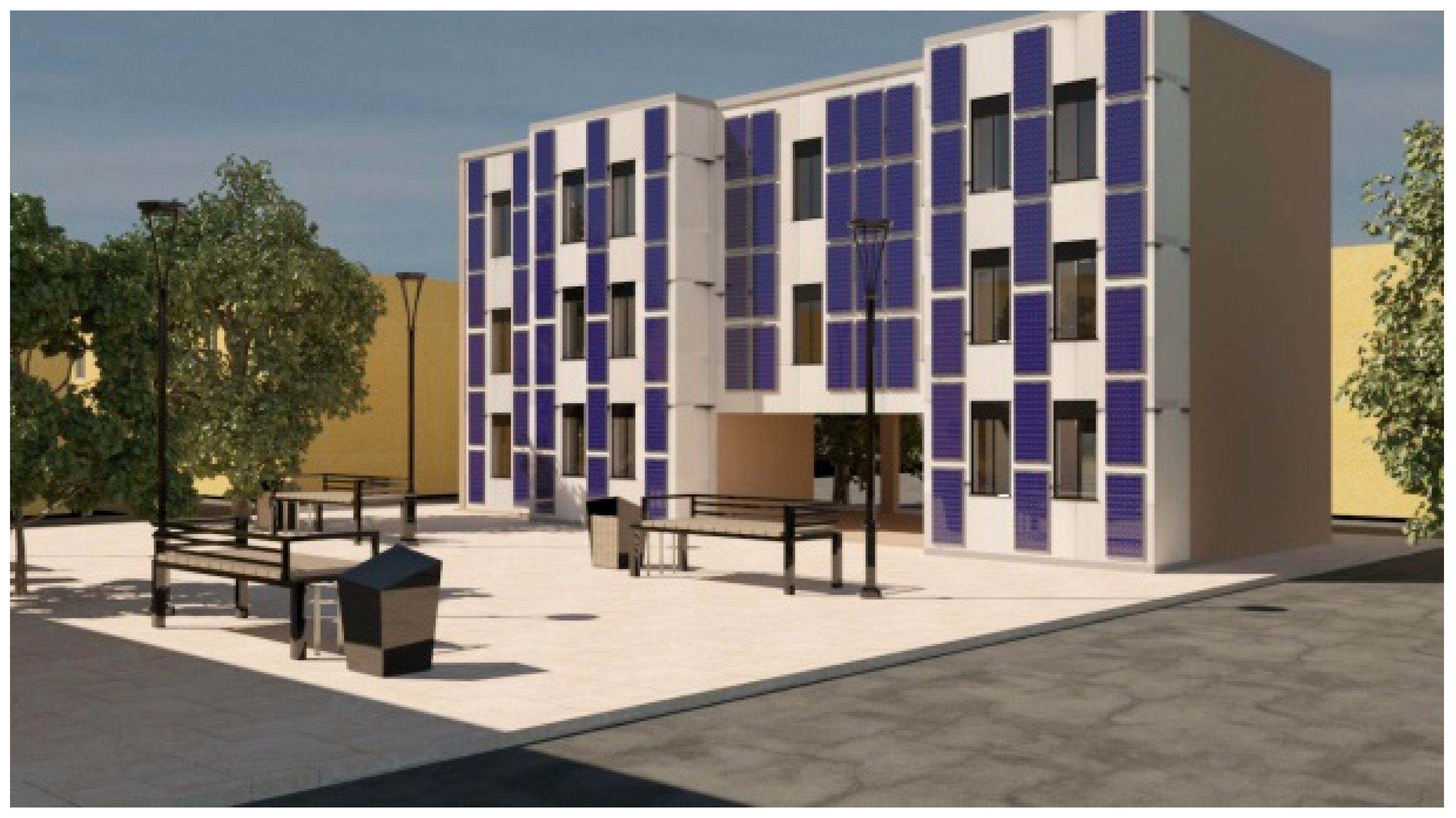
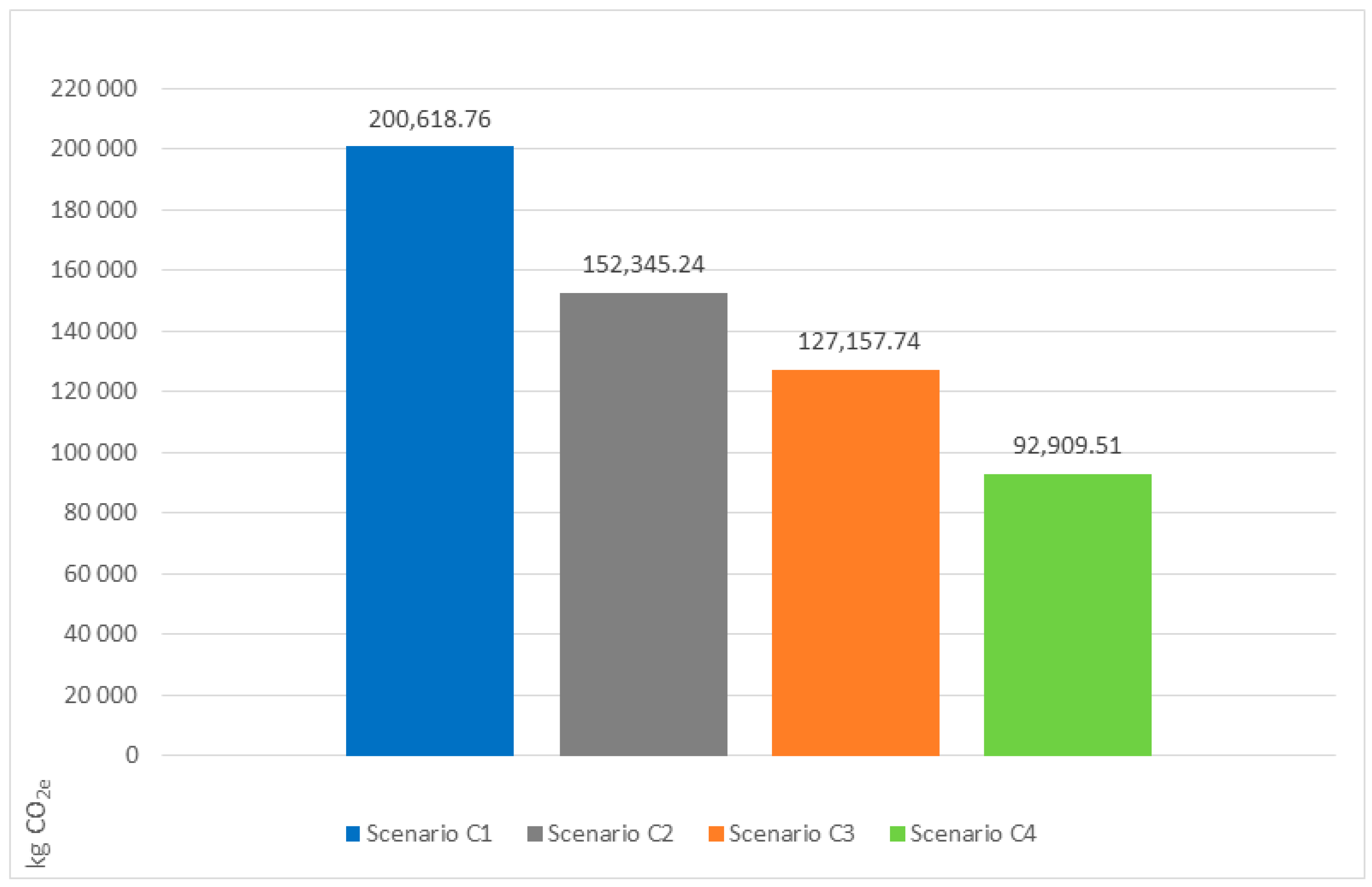
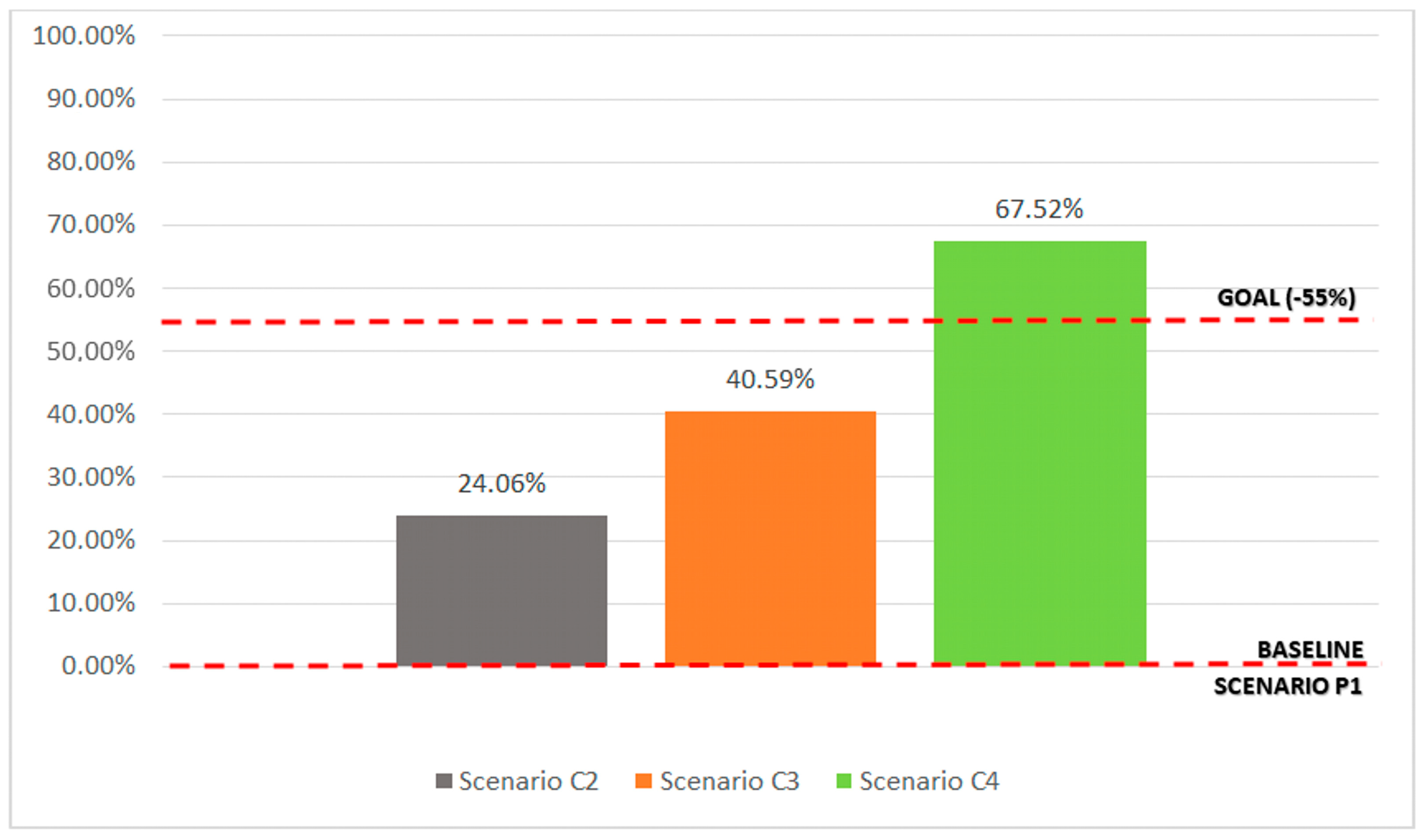
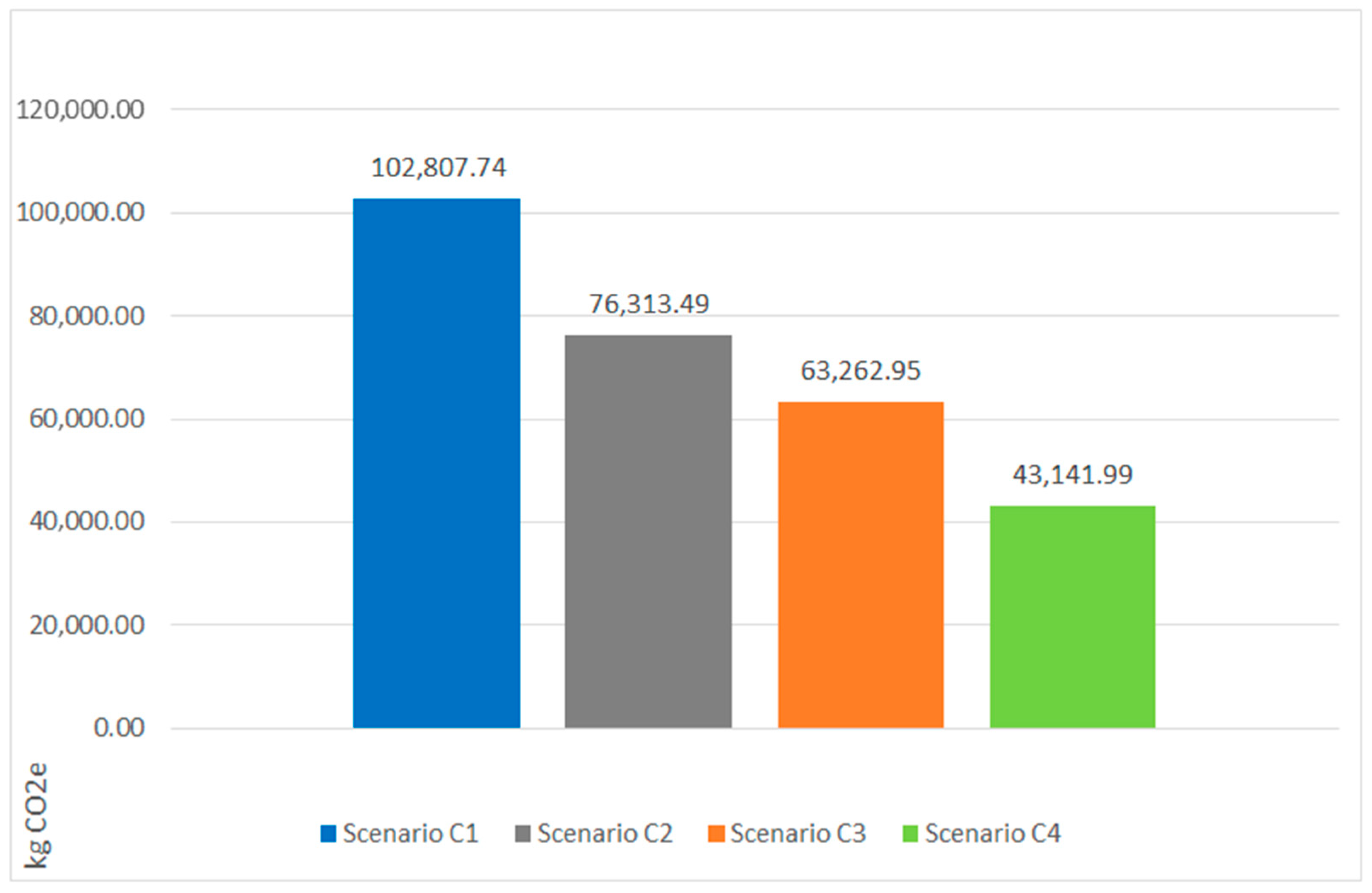

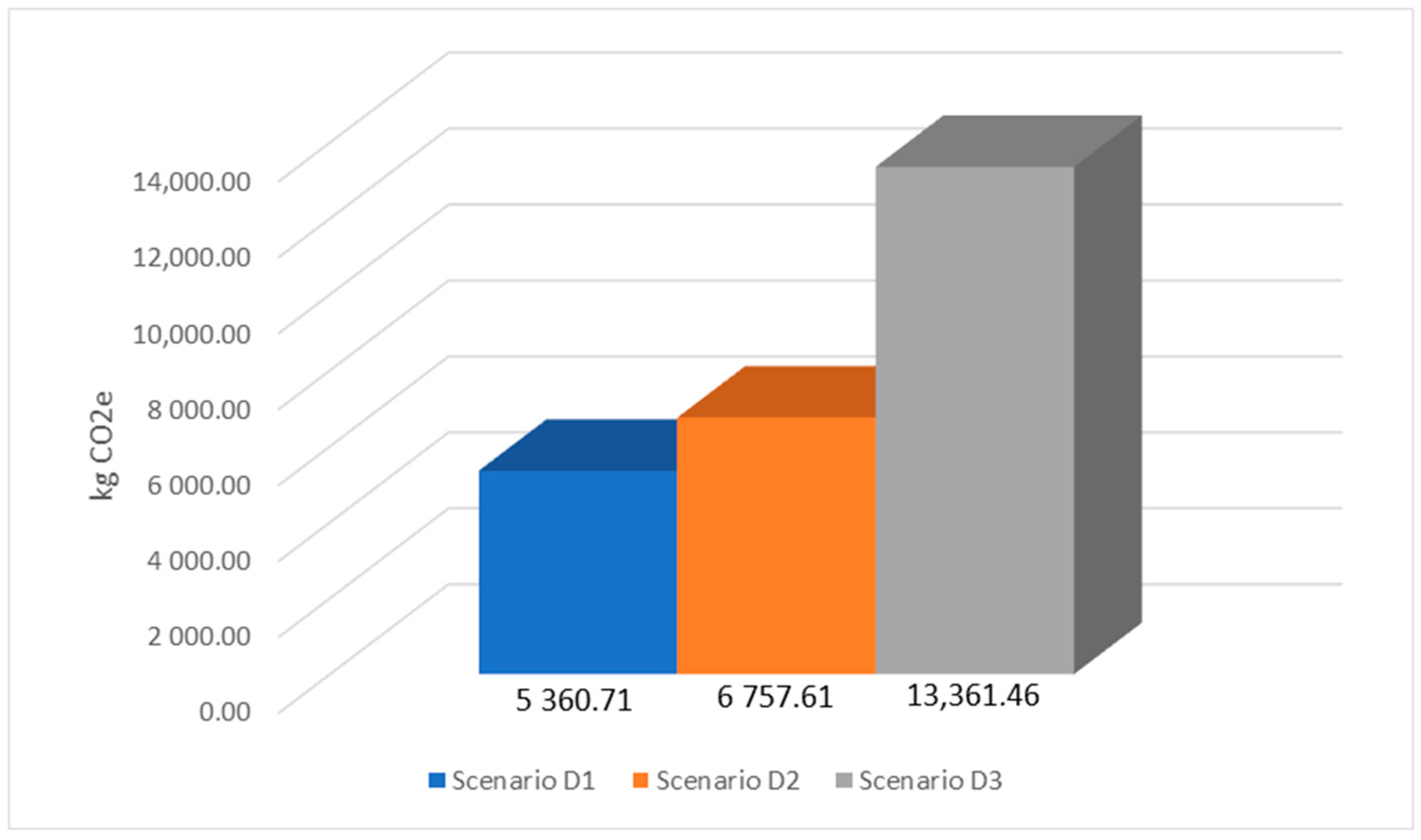
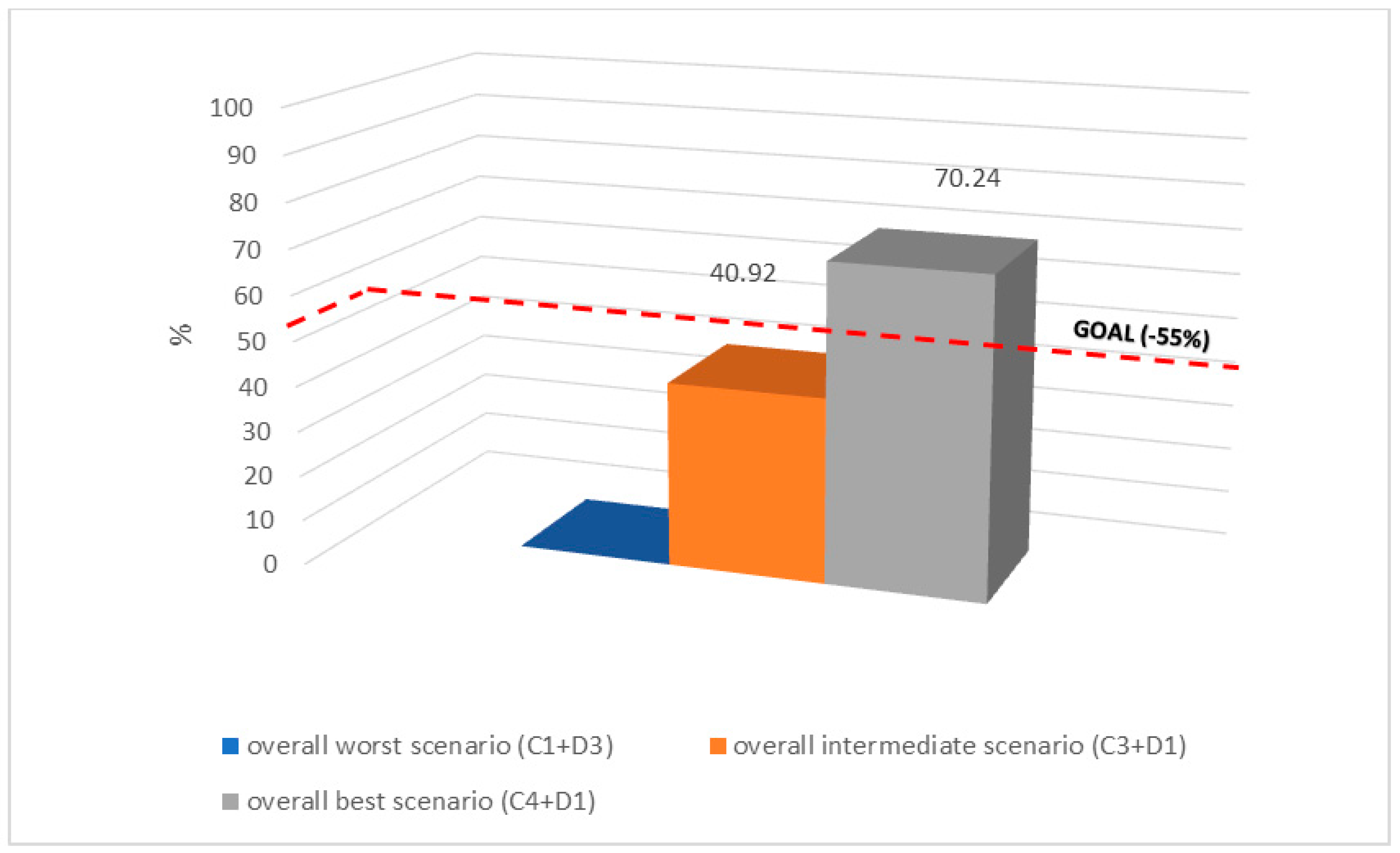
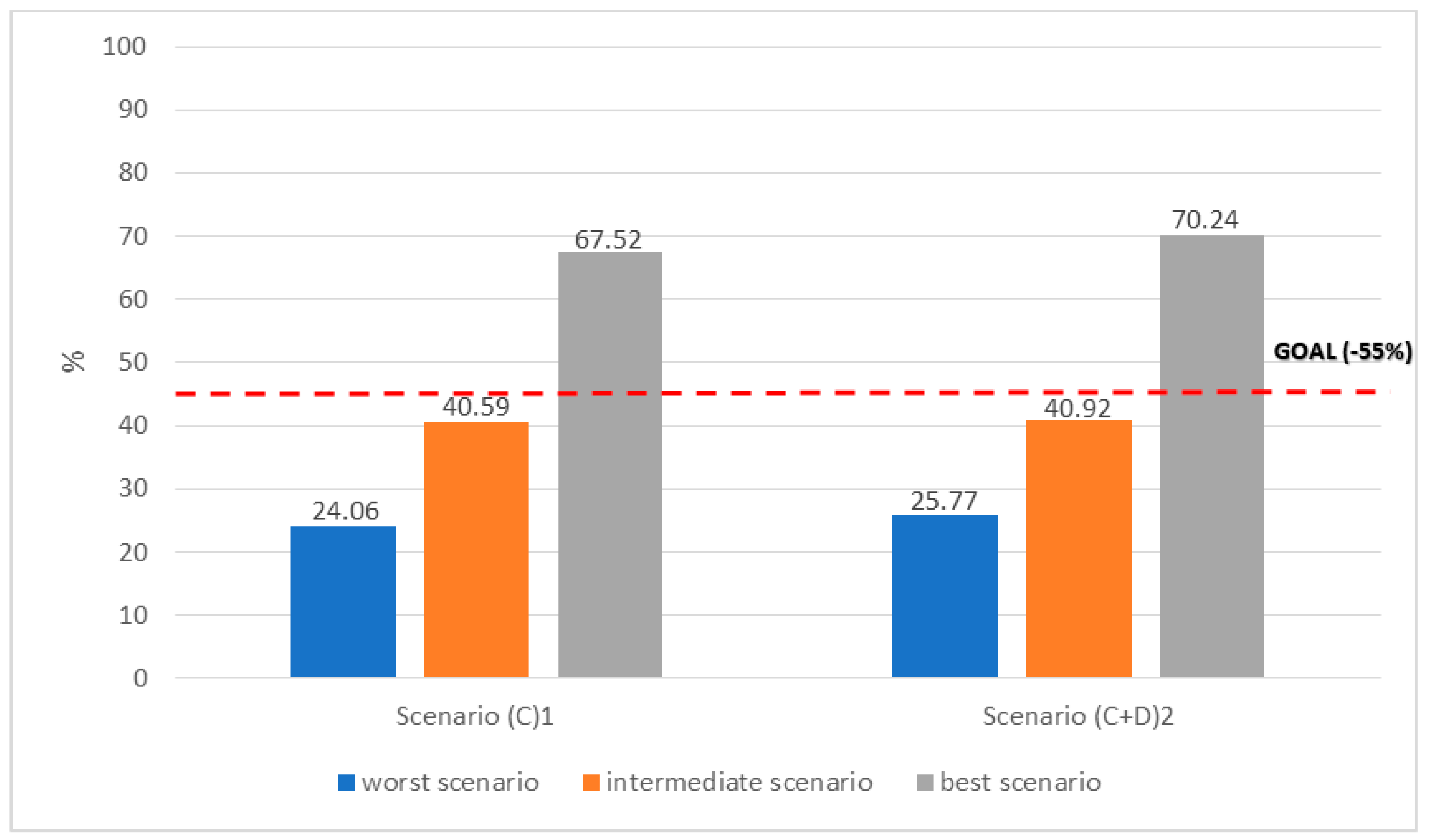
Disclaimer/Publisher’s Note: The statements, opinions and data contained in all publications are solely those of the individual author(s) and contributor(s) and not of MDPI and/or the editor(s). MDPI and/or the editor(s) disclaim responsibility for any injury to people or property resulting from any ideas, methods, instructions or products referred to in the content. |
© 2024 by the author. Licensee MDPI, Basel, Switzerland. This article is an open access article distributed under the terms and conditions of the Creative Commons Attribution (CC BY) license (https://creativecommons.org/licenses/by/4.0/).
Share and Cite
Di Ruocco, G. Renovation Wave in Europe: Low-Carbon Design for the Refurbishment of Social Housing in Southern Italy. Buildings 2024, 14, 1535. https://doi.org/10.3390/buildings14061535
Di Ruocco G. Renovation Wave in Europe: Low-Carbon Design for the Refurbishment of Social Housing in Southern Italy. Buildings. 2024; 14(6):1535. https://doi.org/10.3390/buildings14061535
Chicago/Turabian StyleDi Ruocco, Giacomo. 2024. "Renovation Wave in Europe: Low-Carbon Design for the Refurbishment of Social Housing in Southern Italy" Buildings 14, no. 6: 1535. https://doi.org/10.3390/buildings14061535
APA StyleDi Ruocco, G. (2024). Renovation Wave in Europe: Low-Carbon Design for the Refurbishment of Social Housing in Southern Italy. Buildings, 14(6), 1535. https://doi.org/10.3390/buildings14061535





